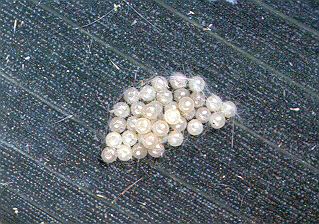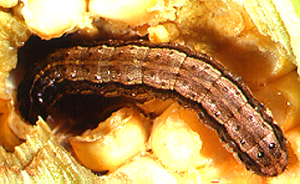Fall armyworm (FAW) is typically a mid-late summer pest of sweet corn in New Jersey. FAW does not overwinter here, and whorl damage often appears in July.
Eggs are laid on corn leaves, and newly emerged larvae consume large quantities of foliage as they rapidly grow. FAW will often feed on seedling stage sweet corn, although whorl is preferred. Under heavy FAW pressure, feeding can stunt plants, and reduce the production of pollen as tassels are consumed. Eggs may also be laid near developing ears, resulting in caterpillars directly penetrating husks and damaging ears.
Larvae are pale green when small, but turn brown as they develop. Larval injury to corn plants is much more destructive than that of ECB. FAW damaged plants often exhibit ragged holes in the leaves, with feeding descending into the whorl. Large quantities of droppings may be found in the whorl, with the actively feeding larva beneath.
FAW populations arriving in New Jersey are frequently resistant to synthetic pyrethroid insecticides. Therefore, it is critical to identify damage properly and be aware of the arrival of this pest to our area so that effective insecticides may be applied. Although the 12% threshold is observed for FAW (alone or in combination with ECB) prior to the development of silks, it is important to understand that silk spray schedules intended to control CEW must be adjusted to utilize materials that will effectively control FAW as well. Current insecticides based on the active ingredients flumendiamide, chlorantraniliprole and spinosad (OMRI approved formulations available) or spinetoram are all effective on FAW as well as ECB and CEW.
FAW population activity (appearance and severity of crop injury and interpretive information) is published throughout the growing season in the Rutgers Plant and Pest Advisory – Vegetable Edition
Identification: Fall Armyworm




